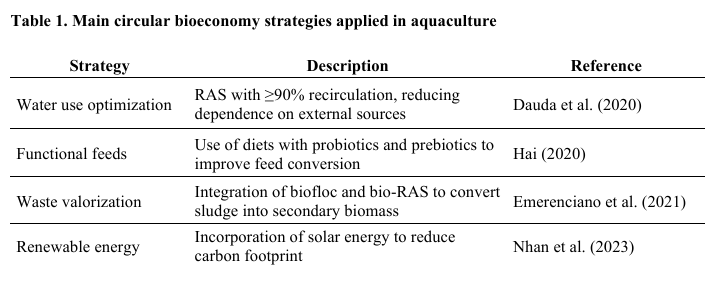CIRCULAR BIOECONOMY IN AQUACULTURE: INNOVATION FOR SUSTAINABILITY IN ARID ZONES
Abstract
The adoption of circular bioeconomy principles in aquaculture represents a key strategy for achieving sustainable development in resource-constrained regions such as La Guajira (Colombia). Based on recent research on intensive tilapia farming (Oreochromis niloticus) and low-impact aquaculture production models (Zimmerman et al., 2023; FAO, 2024), this study evaluates the viability of Recirculating Aquaculture Systems (RAS) as an innovative solution to enhance productivity and reduce environmental impacts. Through case studies in Riohacha and Fonseca, RAS proved to reduce water footprints, improve food security, and generate stable income for rural communities. The proposed model aligns with Sustainable Development Goals (SDGs 2, 6, 12, and 14), offering a replicable framework for arid areas in Latin America.
Keywords: Circular bioeconomy, Recirculating Aquaculture Systems (RAS), sustainability, multitrophic aquaculture, Oreochromis niloticus
Introduction
La Guajira faces severe environmental constraints for aquaculture, characterized by annual rainfall below 500 mm, high evaporation rates, and aquifer salinization (IDEAM, 2023). Conventional aquaculture systems generate between 15 and 20 m³ of effluent per ton of fish, negatively affecting freshwater bodies.
Circular bioeconomy seeks to close water and nutrient cycles through sustainable practices such as RAS and multitrophic systems (Chopin, 2022). This approach integrates technology, environmental management, and resilient food production in water-scarce settings. Table 1 summarizes the main circular bioeconomy strategies applied in aquaculture:
Methodology
Two RAS pilots were evaluated, integrating:
· Biofloc technology: Conversion of nitrogenous waste into microbial biomass
· Aquaponics: Use of effluents to cultivate Oreochromis niloticus
· IoT sensors: Real-time monitoring of pH, oxygen, and temperature
Results
The case studies in Riohacha and Fonseca showed that implementing RAS under circular bioeconomy principles reduced water consumption by 40% compared to traditional systems, significantly contributing to water sustainability in arid zones. Furthermore, consistent production of 8 tons per hectare per year of tilapia was achieved during drought seasons, enhancing local food security. Economically, rural incomes increased by 35% through direct sales in regional markets.
Discussion
The integration of RAS and circular bioeconomy technologies reduces pressure on aquifers and surface water bodies—crucial in arid regions. Additionally, the use of functional feeds improves feed conversion, lowering production costs (Hai, 2020). However, the main barrier identified was the high implementation cost (USD 15,000/ha), which can be mitigated through state incentives and public-private partnerships. The use of renewable energy represents a complementary strategy to further reduce operational costs.
Conclusions
Implementing RAS under a circular bioeconomy approach in La Guajira can:
· Generate 1,200 direct jobs over the next five years.
· Produce more than 1,500 tons per year of sustainable animal and plant protein.
· Reduce pressure on local aquatic ecosystems by 75%.
· Increase the socio-economic resilience of rural communities.
This model has strong replicability potential in other arid regions of Latin America, contributing to SDG achievement and promoting innovation in sustainable aquaculture.
Acknowledgments
Project funded by the Ministry of Science, Universidad de La Sabana, and SENA Colombia.
Correspondence
rhernandezb@sena.edu.co
